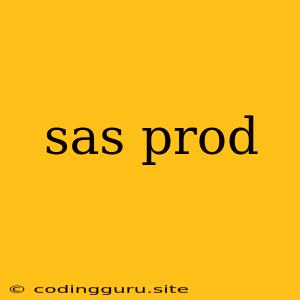Demystifying SAS: What is SAS and What Can it Do?
SAS is a powerful and widely used software suite designed for data management, analysis, and reporting. It's a cornerstone for businesses and researchers seeking to extract valuable insights from their data. But what exactly does SAS stand for? What can SAS do, and how does it differ from other data tools? Let's dive in.
What Does SAS Stand For?
SAS stands for Statistical Analysis System. It's a name that accurately reflects the software's core capabilities. It's built to handle a wide array of statistical tasks, ranging from basic descriptive statistics to complex multivariate analyses.
Key Features of SAS
SAS offers a comprehensive set of tools and features, making it a versatile solution for various data-driven needs. Here are some of its key functionalities:
- Data Management: SAS excels in data cleaning, transformation, and integration. It provides tools for importing data from various sources, handling missing values, merging datasets, and ensuring data consistency.
- Statistical Analysis: This is the heart of SAS. It offers a wide range of statistical procedures for exploring data patterns, testing hypotheses, building predictive models, and uncovering insights.
- Reporting: SAS empowers users to create visually appealing and informative reports. It supports various report formats, including tables, charts, graphs, and interactive dashboards.
- Programming Language: SAS has its own powerful programming language, allowing for greater customization and control over data analysis and reporting processes.
- Data Visualization: SAS provides robust tools for creating interactive and insightful visualizations, helping users to understand data trends and patterns more effectively.
Why Choose SAS?
Several factors contribute to SAS's popularity in various sectors:
- Industry Standard: SAS is a well-established and widely recognized tool, making it a valuable skill to have in many industries.
- Comprehensive Solution: SAS offers a complete suite of data management, analysis, and reporting tools, eliminating the need for multiple disparate software solutions.
- Scalability: SAS can handle massive datasets and complex statistical operations, making it suitable for large enterprises and research institutions.
- Advanced Features: SAS includes advanced features like machine learning algorithms, time series analysis, and forecasting capabilities, allowing for sophisticated data modeling and prediction.
- Strong Support: SAS provides extensive documentation, online support forums, and training resources, ensuring users have the resources they need to succeed.
SAS vs. Other Data Tools
While SAS is a powerful tool, it's not the only option for data analysis. Other tools like R, Python, and SPSS also offer capabilities in this space. Here's a quick comparison:
| Feature | SAS | R | Python | SPSS |
|---|---|---|---|---|
| Price | Licensed Software | Free and Open Source | Free and Open Source | Licensed Software |
| User Interface | Proprietary GUI | Command-line Interface (with GUIs available) | Command-line Interface (with GUIs available) | Proprietary GUI |
| Statistical Power | Excellent | Excellent | Excellent | Excellent |
| Data Management | Strong | Good | Good | Good |
| Visualization | Good | Good | Excellent | Good |
| Learning Curve | Moderate | Steep | Steep | Moderate |
Ultimately, the best tool for your needs depends on your specific requirements, budget, and technical expertise.
Examples of SAS Usage
SAS is used extensively across various industries, including:
- Healthcare: Analyzing patient data to improve treatment outcomes, conduct clinical trials, and identify trends in disease patterns.
- Finance: Managing risk, predicting market trends, and developing financial models.
- Marketing: Analyzing customer behavior, targeting marketing campaigns, and measuring marketing ROI.
- Manufacturing: Optimizing production processes, managing supply chains, and improving quality control.
- Research: Conducting statistical analysis, modeling complex systems, and generating scientific reports.
Getting Started with SAS
To get started with SAS, consider the following:
- Explore Free Resources: SAS offers free online courses and tutorials to introduce you to the basics.
- Take a Course: Formal training courses are available to provide a more comprehensive understanding of SAS.
- Download Trial Version: SAS offers a free trial version to explore its features and functionalities.
Conclusion
SAS is a powerful and comprehensive software suite for data management, analysis, and reporting. It offers a wide range of features, advanced functionalities, and industry-standard recognition. Whether you're a researcher, data scientist, or business analyst, SAS provides the tools you need to extract valuable insights from your data and make informed decisions.
